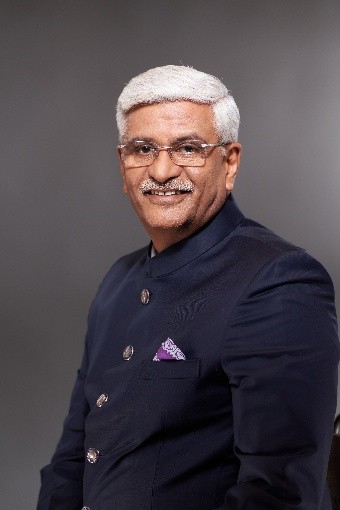 In the last decade, India’s sacred geography has not merely been visited—it has been rediscovered. The mountains are no longer just landscapes; they are living sanctuaries. From the snow-draped shrines of Kedarnath and Badrinath to the meditative calm of Bodh Gaya and the golden stillness of Sarnath, India’s spiritual soul has stirred—one pilgrim at a time. Tourism in this era was not crafted through brochures but through bhakti, memory, and the civilisational impulse to reconnect.
In the last decade, India’s sacred geography has not merely been visited—it has been rediscovered. The mountains are no longer just landscapes; they are living sanctuaries. From the snow-draped shrines of Kedarnath and Badrinath to the meditative calm of Bodh Gaya and the golden stillness of Sarnath, India’s spiritual soul has stirred—one pilgrim at a time. Tourism in this era was not crafted through brochures but through bhakti, memory, and the civilisational impulse to reconnect.
Between 2014 and 2024, this spiritual awakening reshaped the country’s cultural map. Kedarnath, once a symbol of tragedy, rose like a phoenix—welcoming over 16 lakh pilgrims in 2024, up from barely 40,000 a decade earlier. Ujjain, rejuvenated as a city worthy of Mahakal, drew 7.32 crore visitors in 2024. Kashi, reborn in light and sanctity, saw 11 crore people walk its sacred lanes. Bodh Gaya and Sarnath quietly echoed across continents, drawing over 30 lakh seekers in 2023.
And then came a moment that transcended statistics—the Pran Pratishtha of Ram Lalla in Ayodhya in January 2024. It was not an inauguration; it was a restoration of the civilisational heartbeat. In just six months, over 11 crore devotees arrived—not just to witness, but to belong. Equally monumental was the Mahakumbh 2025, the world’s largest spiritual gathering, with over 65 crore pilgrims at the confluence of faith and transcendence. Together, Ayodhya and Prayagraj became twin lighthouses of Bharat’s spiritual renaissance.
This was not tourism—it was homecoming. Under Prime Minister Narendra Modi’s leadership, this return was given shape, infrastructure, and soul. No longer a checklist-driven industry, tourism became a national mission to rediscover the sacred self. PM Modi’s visionary mantra— “Wed in India, Visit India, Invest in India”—recoded tourism into a cultural calling.
From the beginning, the Modi government saw tourism as a force for national revival. Through Swadesh Darshan and its upgrade Swadesh Darshan 2.0, the Ministry of Tourism developed 110 projects under thematic circuits like Ramayana, Buddhist, Coastal, and Tribal. The original scheme launched in 2014–15 sanctioned 76 projects worth ₹5,287.90 crore. Swadesh Darshan 2.0 added 52 projects with ₹2,106.44 crore to develop sustainable destinations.
Under the Challenge-Based Destination Development (CBDD) sub-scheme, 36 projects were sanctioned at ₹623.13 crore, while the SASCI scheme greenlit 40 projects worth ₹3,295.76 crore to enhance state-led tourism infrastructure.
Alongside this, the PRASHAD scheme revitalised 100 pilgrimage towns with upgraded amenities, lighting, and sanitation. These efforts helped India record over 250 crore domestic tourist visits in 2023—an all-time high.
In a landmark announcement, the 2024–25 Union Budget proposed developing 50 tourism destinations, adding them to the Infrastructure Harmonized Master List (IHML) to ease investment and financing.
The revival was not limited to sacred spaces. The Statue of Unity, unveiled in 2018, became one of the nation’s most visited monuments, drawing over 50 lakh visitors in 2023. Around it flourished eco-tourism parks, tent cities, and tribal museums—transforming tribute into opportunity.
India’s civilisational confidence began reflecting in its diplomacy. Leaders from France, Japan, UAE, Australia, and South Korea were received not just in Delhi, but in Varanasi, Udaipur, Ayodhya, and Mahabalipuram. Soft power was no longer soft—it was immersive. River cruises, Deepotsavs, spiritual walks, and cultural showcases turned statecraft into soulcraft.
Meanwhile, Incredible India 2.0 rebranded the nation from a land of monuments to a land of transformation. Yoga in Rishikesh, Ayurveda in Kerala, tribal festivals in the Northeast, and craft trails in Kutch gave rise to vibrant niche tourism ecosystems. Marketing was now inseparable from memory.
The sector’s economic footprint grew equally impressive. Between April 2000 and December 2023, India attracted over US $18 billion in FDI in tourism. Major hospitality infrastructure projects saw US $9 billion in investment from 2014–22. In 2023 alone, India earned ₹2.31 lakh crore (US $28.7 billion) in foreign exchange, with 9.52 million foreign tourists, marking a 47.9% growth over the previous year. The sector generated 84.63 million jobs in 2023–24, up by 8.46 million from the previous year—emerging as a cornerstone of India’s development and employment.
Tourism evolved into a full-spectrum mission. The Adopt a Heritage scheme brought in corporate stewardship of key sites, while UDAN connected far-flung places like Shirdi, Ziro, and Minicoy by air. The National Digital Tourism Mission began unifying bookings, data, and itineraries into one integrated platform.
The Northeast—once neglected—emerged as a crown jewel. Thanks to the Act East policy and focused infrastructure, tourist arrivals in states like Arunachal, Sikkim, and Meghalaya doubled between 2014 and 2022. The Vibrant Villages Program transformed remote hamlets like Kibithu and Mana into destinations where patriotism meets nature and heritage.
The idea of tourism also became aspirational. “Wed in India” translated into incentives, campaigns, and infrastructure support across wedding hubs like Rajasthan and Goa. Meanwhile, medical and wellness tourism drew over 6 lakh foreign patients in 2022—positioning India among the world’s leading healing destinations.
India’s G20 Presidency in 2023 was a masterpiece of cultural diplomacy. Rather than being limited to Delhi, over 60 destinations—from Khajuraho to Kumarakom—hosted global events, each curated with local art, food, and heritage. The world was not just negotiating with India—it was experiencing her.
But behind the numbers, the real transformation was spiritual. India stopped asking the world to see her monuments. She invited the world to feel her memory, heal in her silence, and celebrate her diversity.
In this new Bharat, tourism is not seasonal—it is civilisational. It is where darshan meets development, where pilgrimage meets progress, and where festivals meet infrastructure. Under Narendra Modi’s leadership, India did not just welcome the world—she embraced it.
As monks circle the Bodhi Tree, as pilgrims chant in Kedarnath’s crisp air, as brides marry beneath palatial domes, and as border villages host curious travellers, one truth echoes through every sacred path and silent corridor: India is not just a destination you visit—it is a country you return to, again and again, in search of something eternal.
– Gajendra Singh Shekhawat, Union Minister of Culture and Tourism, Government of India
 TravTalk India Online Magazine
TravTalk India Online Magazine






